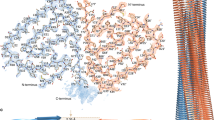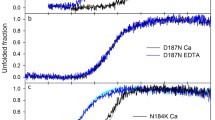Abstract
Mutations in the gelsolin protein are responsible for a rare conformational disease known as AGel amyloidosis. Four of these mutations are hosted by the second domain of the protein (G2): D187N/Y, G167R and N184K. The impact of the latter has been so far evaluated only by studies on the isolated G2. Here we report the characterization of full-length gelsolin carrying the N184K mutation and compare the findings with those obtained on the wild type and the other variants. The crystallographic structure of the N184K variant in the Ca2+-free conformation shows remarkable similarities with the wild type protein. Only minimal local rearrangements can be observed and the mutant is as efficient as the wild type in severing filamentous actin. However, the thermal stability of the pathological variant is compromised in the Ca2+-free conditions. These data suggest that the N to K substitution causes a local disruption of the H-bond network in the core of the G2 domain. Such a subtle rearrangement of the connections does not lead to significant conformational changes but severely affects the stability of the protein.





Similar content being viewed by others
References
Afonine PV, Poon BK, Read RJ et al (2018) Real-space refinement in PHENIX for cryo-EM and crystallography. Acta Crystallogr D Struct Biol 74:531–544
Ashish PMS, Perryman PB et al (2007) Global structure changes associated with Ca2+ activation of full-length human plasma gelsolin. J Biol Chem 282:25884–25892
Badmalia MD, Singh S, Garg R, Ashish PMS (2017) Visualizing temperature mediated activation of gelsolin and its deactivation by pip: a Saxs based study. Sci Rep 7:4670
Bollati M, Scalone E, Bonì F et al (2019) High-resolution crystal structure of gelsolin domain 2 in complex with the physiological calcium ion. Biochem Biophys Res Commun 518:94–99
Bonì F, Milani M, Porcari R et al (2016) Molecular basis of a novel renal amyloidosis due to N184K gelsolin variant. Sci Rep 6:33463
Bonì F, Milani M, Barbiroli A et al (2018) Gelsolin pathogenic Gly167Arg mutation promotes domain-swap dimerization of the protein. Hum Mol Genet 27:53–65
Burtnick LD, Koepf EK, Grimes J et al (1997) The crystal structure of plasma gelsolin: implications for actin severing, cap**, and nucleation. Cell 90:661–670
Chen CD, Huff ME, Matteson J et al (2001) Furin initiates gelsolin familial amyloidosis in the Golgi through a defect in Ca(2+) stabilization. EMBO J 20:6277–6287
Clabbers MTB, Gruene T, Parkhurst JM et al (2018) Electron diffraction data processing with DIALS. Acta Crystallogr D Struct Biol 74:506–518
de la Chapelle A, Tolvanen R, Boysen G et al (1992) Gelsolin-derived familial amyloidosis caused by asparagine or tyrosine substitution for aspartic acid at residue 187. Nat Genet 2:157–160
de Rosa M, Barbiroli A, Giorgetti S et al (2015) Decoding the structural bases of D76N ß2-microglobulin high amyloidogenicity through crystallography and Asn-Scan mutagenesis. PLoS ONE 10:e0144061
Efebera YA, Sturm A, Baack EC et al (2014) Novel gelsolin variant as the cause of nephrotic syndrome and renal amyloidosis in a large kindred. Amyloid 21:110–112
Emsley P, Lohkamp B, Scott WG, Cowtan K (2010) Features and development of Coot. Acta Crystallogr D Biol Crystallogr 66:486–501
Evans PR, Murshudov GN (2013) How good are my data and what is the resolution? Acta Crystallogr D Biol Crystallogr 69:1204–1214
Garg R, Peddada N, Sagar A et al (2011) Visual insight into how low pH alone can induce actin-severing ability in gelsolin under calcium-free conditions. J Biol Chem 286:20387–20397
Giorgino T, Mattioni D, Hassan A et al (2019) Nanobody interaction unveils structure, dynamics and proteotoxicity of the Finnish-type amyloidogenic gelsolin variant. Biochim Biophys Acta Mol Basis Dis 1865:648–660
Huff ME, Page LJ, Balch WE, Kelly JW (2003) Gelsolin domain 2 Ca2+ affinity determines susceptibility to furin proteolysis and familial amyloidosis of finnish type. J Mol Biol 334:119–127
Isaacson RL, Weeds AG, Fersht AR (1999) Equilibria and kinetics of folding of gelsolin domain 2 and mutants involved in familial amyloidosis-Finnish type. Proc Natl Acad Sci USA 96:11247–11252
Kabsch W (2010) XDS. Acta Crystallogr Sect D Biol Crystallogr 66:125–132
Kazmirski SL, Howard MJ, Isaacson RL, Fersht AR (2000) Elucidating the mechanism of familial amyloidosis-Finnish type: NMR studies of human gelsolin domain 2. Proc Natl Acad Sci USA 97:10706–10711
Kazmirski SL, Isaacson RL, An C et al (2002) Loss of a metal-binding site in gelsolin leads to familial amyloidosis-Finnish type. Nat Struct Biol 9:112–116
Khaitlina S, Walloscheck M, Hinssen H (2004) Calcium-induced conformational changes in the C-terminal half of gelsolin stabilize its interaction with the actin monomer. Biochemistry 43:12838–12845
Kiselar JG, Janmey PA, Almo SC, Chance MR (2003) Structural analysis of gelsolin using synchrotron protein footprinting. Mol Cell Proteomics 2:1120–1132
Laskowski RA, Swindells MB (2011) LigPlot: multiple ligand-protein interaction diagrams for drug discovery. J Chem Inf Model 51:2778–2786
McCoy AJ, Grosse-Kunstleve RW, Adams PD et al (2007) Phaser crystallographic software. J Appl Crystallogr 40:658–674
Meretoja J (1969) Familial systemic paramyloidosis with lattice dystrophy of the cornea, progressive cranial neuropathy, skin changes and various internal symptoms. A previously unrecognized heritable syndrome. Ann Clin Res 1:314–324
Nag S, Ma Q, Wang H et al (2009) Ca2+ binding by domain 2 plays a critical role in the activation and stabilization of gelsolin. Proc Natl Acad Sci USA 106:13713–13718
Nag S, Larsson M, Robinson RC, Burtnick LD (2013) Gelsolin: the tail of a molecular gymnast. Cytoskeleton 70:360–384
Nicholls RA, Fischer M, McNicholas S, Murshudov GN (2014) Conformation-independent structural comparison of macromolecules with ProSMART. Acta Crystallogr D Biol Crystallogr 70:2487–2499
Page LJ, Suk JY, Huff ME et al (2005) Metalloendoprotease cleavage triggers gelsolin amyloidogenesis. EMBO J 24:4124–4132
Patel VB, Zhabyeyev P, Chen X et al (2018) PI3Kα-regulated gelsolin activity is a critical determinant of cardiac cytoskeletal remodeling and heart disease. Nat Commun 9:5390
Pope B, Maciver S, Weeds A (1995) Localization of the calcium-sensitive actin monomer binding site in gelsolin to segment 4 and identification of calcium binding sites. Biochemistry 34:1583–1588
Ratnaswamy G, Huff ME, Su AI et al (2001) Destabilization of Ca2 -free gelsolin may not be responsible for proteolysis in Familial Amyloidosis of Finnish Type. Proc Natl Acad Sci 98:2334–2339
Sethi S, Theis JD, Quint P et al (2013) Renal amyloidosis associated with a novel sequence variant of gelsolin. Am J Kidney Dis 61:161–166
Solomon JP, Yonemoto IT, Murray AN et al (2009) The 8 and 5 kDa fragments of plasma gelsolin form amyloid fibrils by a nucleated polymerization mechanism, while the 68 kDa fragment is not amyloidogenic. Biochemistry 48:11370–11380
Srivastava A, Singh J, Singh Yadav SP et al (2018) The Gelsolin pathogenic D187N mutant exhibits altered conformational stability and forms amyloidogenic oligomers. Biochemistry 57:2359–2372
Szatmári D, Xue B, Kannan B et al (2018) ATP competes with PIP2 for binding to gelsolin. PLoS ONE 13:e0201826
Vanoni MA, Vitali T, Zucchini D (2013) MICAL, the flavoenzyme participating in cytoskeleton dynamics. Int J Mol Sci 14:6920–6959
Vitali T, Maffioli E, Tedeschi G, Vanoni MA (2016) Properties and catalytic activities of MICAL1, the flavoenzyme involved in cytoskeleton dynamics, and modulation by its CH, LIM and C-terminal domains. Arch Biochem Biophys 593:24–37
Zapun A, Grammatyka S, Déral G, Vernet T (2000) Calcium-dependent conformational stability of modules 1 and 2 of human gelsolin. Biochem J 350(Pt 3):873–881
Zorgati H, Larsson M, Ren W et al (2019) The role of gelsolin domain 3 in familial amyloidosis (Finnish type). Proc Natl Acad Sci USA 116:13958–13963
Acknowledgments
This research was supported by a Research Grant of the Amyloidosis Foundation (Michigan, United States) awarded to MdR. The diffraction experiments were performed on beamline ID23-1, ID29 and Massif-3 at the European Synchrotron Radiation Facility (ESRF, France). We are thankful for the provided beamtime and assistance during the measurements.
Author information
Authors and Affiliations
Corresponding author
Ethics declarations
Conflict of interest
The authors declare that they have no conflict of interest.
Additional information
Publisher's Note
Springer Nature remains neutral with regard to jurisdictional claims in published maps and institutional affiliations.
Rights and permissions
About this article
Cite this article
de Rosa, M., Barbiroli, A., Bonì, F. et al. The structure of N184K amyloidogenic variant of gelsolin highlights the role of the H-bond network for protein stability and aggregation properties. Eur Biophys J 49, 11–19 (2020). https://doi.org/10.1007/s00249-019-01409-9
Received:
Revised:
Accepted:
Published:
Issue Date:
DOI: https://doi.org/10.1007/s00249-019-01409-9




